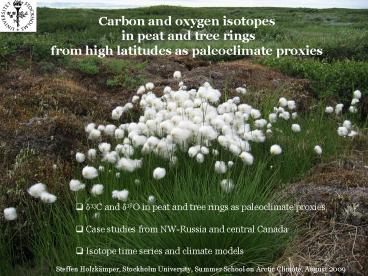Carbon and oxygen isotopes - PowerPoint PPT Presentation
1 / 26
Title: Carbon and oxygen isotopes
1
Carbon and oxygen isotopes in peat and tree
rings from high latitudes as paleoclimate
proxies
- d13C and d18O in peat and tree rings as
paleoclimate proxies - Case studies from NW-Russia and central Canada
- Isotope time series and climate models
Steffen Holzkämper, Stockholm University, Summer
School on Arctic Climate, August 2009
2
Arctic ??
- Definitions
- gt60N
- gt66.5 N
- 10C isotherm of warmest month
- Arctic tree line
- ?
- Why study trees in an arctic context?
- Former and future boundaries of the Arctic
- Relevance for the carbon pool
- Forest islands in the Arctic
3
Used for paleoclimate research Mainly
Deuterium, oxygen-18, and carbon-13
In atmospheric oxygen
In atmospheric carbon
In ocean water
12C 98.9 13C 1.1 14C 1 ppt
1H 99.9 2H 0.015 (154 ppm) 3H ltlt
16O 99.759 17O 0.0037 18O 0.204
Nomenclature The delta notation in permill,
i.e. given as the departure from a standard
- Positive values mean sample has more of the
heavier isotope than the standard enriched - Negative values mean sample has fewer of the
heavier isotope than the standard depleted
4
Fractionation of isotopes For water isotopes
(d18O and D) the most important fractionation
occurs during phase transitions Evaporation,
condensation, freezing, thawing. This
fractionation is temperature dependent! E.g.
fractionation coefficient for 18O/16O a 1.012
(0C), a 1.009 (30C) For carbon isotopes
the most important fractionation occurs during
photosynthesis (in the stomata or cell surface of
plants)
5
The water isotopes in the water cycle
Coplen and Kendall (2000), US Geological Survey
6
Global Network of Isotopes in Precipitation (GNIP,
IAEA)
7
d18O in tree rings
McCarroll and Loader (2004), Quaternary Science
Reviews
8
Isotopes in tree rings
- Why?
- Proxy for additional parameters
- Absence of biologically induced growth trend
apparent in ring width - How?
- Sampling of single tree ring material or at lower
resolution - Isolation of cellulose to get rid of lignins,
sugars etc.
9
- Why do we need additional proxies from trees ?
- Decadal summer temperature trends ? annual trends
- Lack of precipitation and circulation records
- Problem of identifying realistic low frequency
signal from ring width
NW-Russia
e
e
Confirmed by data from Briffa et al. 2008
10
d13C in tree rings
McCarroll and Loader (2004), Quaternary Science
Reviews
11
Proxy d13C and d18O of a-cellulose fraction
from...
Single tree rings (Picea glauca/Picea obovata)
Stems or branches from Sphagnum mosses
12
Tree ring separation and homogenization
Extraction of alpha-cellulose
Mass spectrometry
d13C d18O
13
Case Study I Moreju River, NW-Russian Arctic
14
The study site (June 2004)
T5
T3
T4
T1
- Presence of trees 100 km north of the
tree-line due to - Favorable microclimatic conditions
- Local absence of permafrost
T2
15
Tree ring isotopes from subarctic Russia
- d18O
- Depending on
- d18O of precipitation
- local evapotranspiration
- d13C
- Depending on
- stomatal conductance (moisture stress)
- photosynthetic rate (temp., light)
- Holzkämper and Kuhry (2008), PAGES Newsletter
- Holzkämper et al. (2008), Geochronometria
16
Correlation with monthly temperature
Correlation with monthly precipitation
17
Reconstruction of winter precipitation
18
Tree ring series from Rogovaya and Moreju
19
(No Transcript)
20
Intra-seasonal climate reconstruction using
stable isotope analysis - a case study on trees
from Prince Albert (Saskatchewan)
Dodd et al. (2008), Chemical Geology
21
Stable isotopes in peat
Loader et al. (2007), The Holocene
22
Case study II Stable carbon isotopes in Sphagnum
peat from north-central Canada
Carbon isotopes in Sphagnum peat correlate with
summer temperature and may be used as proxies for
Holocene summer temperature changes
Kaislahti-Tillman et al., submitted
23
d13C and d18O in Sphagnum peat from arctic Canada
Sphagnum fuscum hummock d13C compared with summer
temperature.
Holocene Sphagnum fuscum peat profile d13C. Long
term climate reconstruction...
Combining tree ring and peat isotope time series
will help deciphering underlying mechanisms and
processes!
Kaislahti-Tillman et al., in prep.
24
Oxygen isotopes in precipitation can be simulated
very well with GCMs/RCMs !
REMOiso nested in ECHAM 4.5iso
Sturm et al. (2005), Hydrological Processes
25
Measured and modelled monthly d18O in
precipitation
Our main study sites
Possibility to compare isotope time series with
modelled isotopes in climate models!
26
- Summary and outlook
- Isotopes are useful proxies for past climate and
environmental changes - Isotope analysis is a farely cheap and widely
applied method in paleoclimatology - A very dynamic research area, both
methodologically and in process understanding - It gives independent results...
- There is no simple transfer function isotope
climate parameter - Regional and local conditions have to be
carefully investigated - Possibility to link stable isotopes with climate
models































